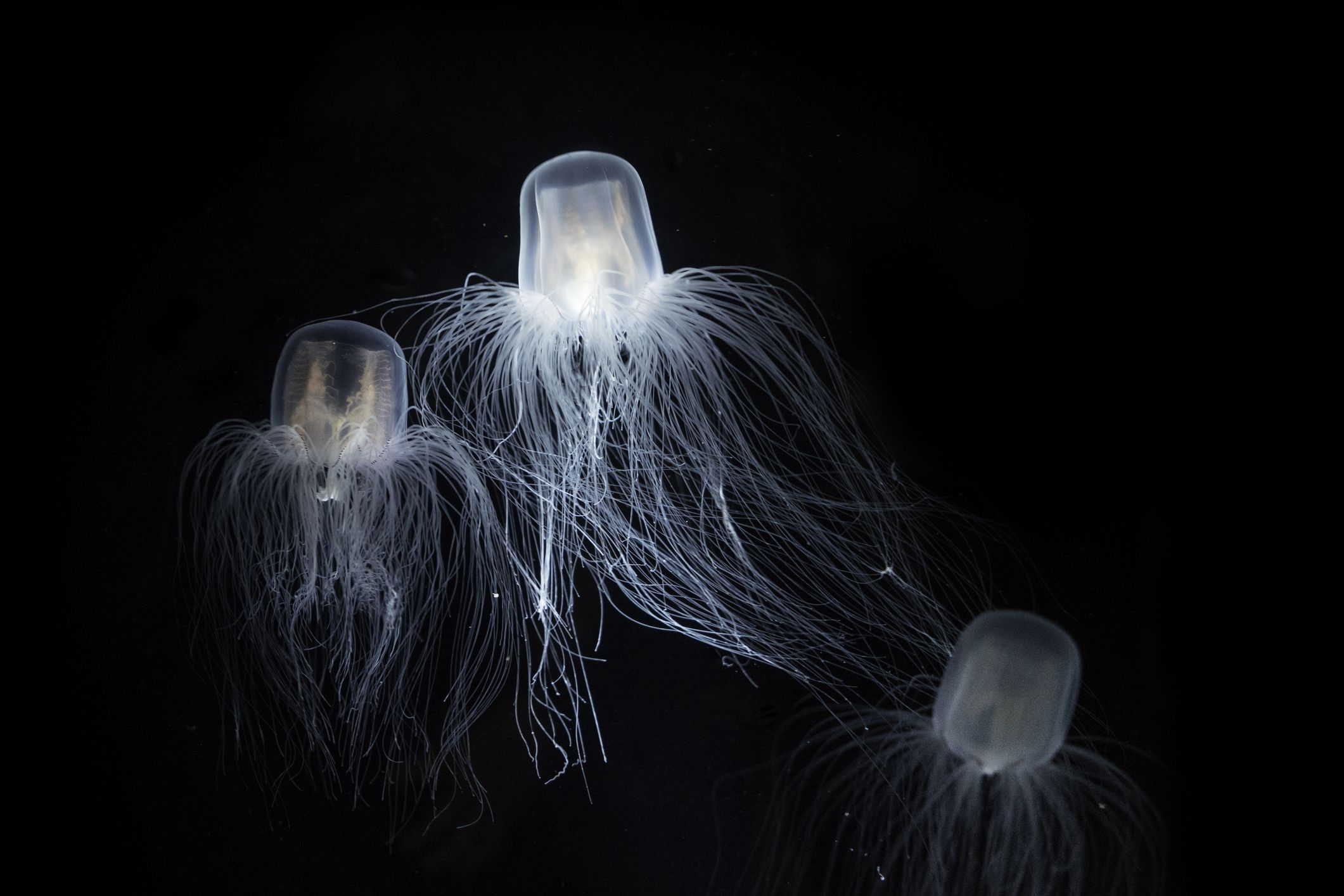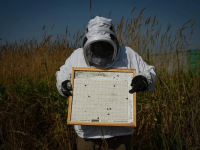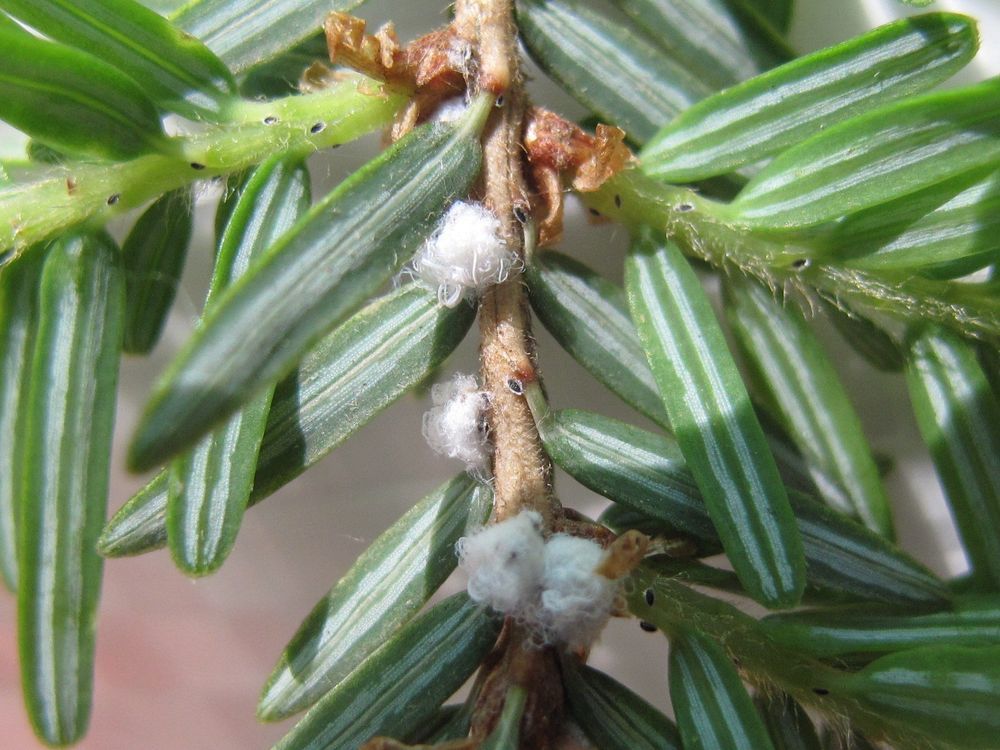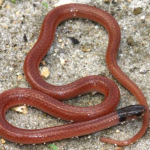Positively Foggian!I think that brings us back to the 'holes are social constructs' part of the conversation. Nicely symmetrical.
Science & Environment
- Thread starter socratus
- Start date
You are using an out of date browser. It may not display this or other websites correctly.
You should upgrade or use an alternative browser.
You should upgrade or use an alternative browser.
Rehab (rehabilitation) is usually corrected by physicists with the " method of renormalization"Rehab usually.
and by deep religious society with "reincarnation method".
The result of these different terms is the same - existence never ends.
Yeah - i have a few days that feel that way too now and again.The result of these different terms is the same - existence never ends.
Some fear health impact from cellphones and EMF
Author of the article ostmedia News
ostmedia News
Publishing date:Aug 19, 2022 • 18 hours ago • 2 minute read • Join the conversation
Despite assurances from Health Canada, almost a third of Canadians surveyed say they are concerned about how daily use of cellphones, WiFi and other devices that emit radio frequency electromagnetic fields (EMF) will affect their health.
Regulators have consistently maintained wireless devices pose no danger to human health.
Asked, “How concerned are you about daily or regular usage of products like these that emit various forms of radiation?” 31% of Canadians surveyed said they were concerned.
Researchers said the survey was intended to counter, “dissemination of misinformation and disinformation regarding the health risks posed by these technologies.”
The survey sample was 5,000 people nationwide. The health department paid the Strategic Counsel $100,033 for the survey.
Most survey respondents were not particularly concerned about daily or regular use of products. A majority of those surveyed (54%), said they used their cellphone “all the time,” holding the phone directly to their ear.
The health department has assured parliament that radio waves from wireless devices pose no danger to the public.
“I’m confident they do not represent a risk,” Andrew Adams, then-director of the department’s environmental and radiation health sciences directorate, said in 2015 during testimony at the Commons health committee.
Access To Information records obtained in 2015 detailed in-house memos in which Department of Health managers discussed public fears of cancer risks from wireless devices.
“As a father of two children and a member of my own community I understand concerns with respect to cell towers,” wrote Art Thansandote, then-chief of the electromagnetics division at the health department’s radiation health sciences directorate.
“However as a scientist I must take a look at the issue from a scientific point of view. There is no evidence that using a cellphone causes brain tumours.”
Thansandote continued, “Public exposure to radiofrequency energy from cellular base stations, e.g. cellphone towers, is at a much lower level than that from cellphones.
“Worse case exposure levels emitted from these devices are typically thousands of times below those specified in science-based exposure standards.
In 2014, then-Conservative MP Terence Young (Oakville, Ont.) introduced a private bill: C-648 An Act Respecting The Prevention Of Potential Health Risks From Radiofrequency Electromagnetic Radiation.
It was intended to force manufacturers to label cellphones and other wireless devices with health warnings.
“If there is no risk to holding a phone to your head or putting it in your pocket, why is the industry burying warnings where no one will see them?” Young asked.
The measure would have required manufacturers and retailers to place large labels on packaging for devices from WiFi units to baby monitors.
The bill lapsed in 2015.

 torontosun.com
torontosun.com
Author of the article
Publishing date:Aug 19, 2022 • 18 hours ago • 2 minute read • Join the conversation
Despite assurances from Health Canada, almost a third of Canadians surveyed say they are concerned about how daily use of cellphones, WiFi and other devices that emit radio frequency electromagnetic fields (EMF) will affect their health.
Regulators have consistently maintained wireless devices pose no danger to human health.
Asked, “How concerned are you about daily or regular usage of products like these that emit various forms of radiation?” 31% of Canadians surveyed said they were concerned.
Researchers said the survey was intended to counter, “dissemination of misinformation and disinformation regarding the health risks posed by these technologies.”
The survey sample was 5,000 people nationwide. The health department paid the Strategic Counsel $100,033 for the survey.
Most survey respondents were not particularly concerned about daily or regular use of products. A majority of those surveyed (54%), said they used their cellphone “all the time,” holding the phone directly to their ear.
The health department has assured parliament that radio waves from wireless devices pose no danger to the public.
“I’m confident they do not represent a risk,” Andrew Adams, then-director of the department’s environmental and radiation health sciences directorate, said in 2015 during testimony at the Commons health committee.
Access To Information records obtained in 2015 detailed in-house memos in which Department of Health managers discussed public fears of cancer risks from wireless devices.
“As a father of two children and a member of my own community I understand concerns with respect to cell towers,” wrote Art Thansandote, then-chief of the electromagnetics division at the health department’s radiation health sciences directorate.
“However as a scientist I must take a look at the issue from a scientific point of view. There is no evidence that using a cellphone causes brain tumours.”
Thansandote continued, “Public exposure to radiofrequency energy from cellular base stations, e.g. cellphone towers, is at a much lower level than that from cellphones.
“Worse case exposure levels emitted from these devices are typically thousands of times below those specified in science-based exposure standards.
In 2014, then-Conservative MP Terence Young (Oakville, Ont.) introduced a private bill: C-648 An Act Respecting The Prevention Of Potential Health Risks From Radiofrequency Electromagnetic Radiation.
It was intended to force manufacturers to label cellphones and other wireless devices with health warnings.
“If there is no risk to holding a phone to your head or putting it in your pocket, why is the industry burying warnings where no one will see them?” Young asked.
The measure would have required manufacturers and retailers to place large labels on packaging for devices from WiFi units to baby monitors.
The bill lapsed in 2015.

Some fear health impact from cellphones and EMF
Almost a third of Canadians are concerned about how use of cellphones, WiFi and other devices that emit EMF will affect their health.
Rainwater not safe to drink — even in remote corners of the globe: Study
Author of the article ostmedia News
ostmedia News
Publishing date:Aug 21, 2022 • 12 hours ago • 1 minute read • Join the conversation
New research has revealed a growing prevalence of highly toxic “forever chemicals” known as PFAS in rainwater in the Great Lakes basin, increasing fears about the negative health effects for humans and wildlife. In this file photo a storm front passes over Devonshire Mall in Windsor on June 18, 2014.
New research has revealed a growing prevalence of highly toxic “forever chemicals” known as PFAS in rainwater in the Great Lakes basin, increasing fears about the negative health effects for humans and wildlife. In this file photo a storm front passes over Devonshire Mall in Windsor on June 18, 2014. PHOTO BY JASON KRYK /Windsor Star
There’s nowhere on Earth where rainwater is safe to drink, according to a new study.
It doesn’t matter if no humans are around in remote locations on the planet, pollution still gets there, according to the study published by researchers from Stockholm University and ETH Zurich.
While the scientists can’t make the claim with 100% certainty, they believe it to be the case because human-made chemicals have been found in remote areas. These chemicals don’t break down easily, so they stick around for decades — sometimes forever.
“Over time, winds and rain carry these ‘forever chemicals’ across oceans and continents until they land somewhere and begin accumulating,” the Weather Network said.
The chemicals can cause cancer, diabetes, infertility and immune system problems, among other issues.
Analysis of samples from remote parts of Tibet and Antarctica revealed that some of these chemicals remain in the atmosphere despite their production being phased out by manufacturers. Due to natural processes, such as the water cycle and wind patterns, the chemicals were observed continuously cycling through the atmosphere and environment, according to the Weather Network.
And it was added that the levels at these remote locations “often exceed” the recommended limit of some chemicals as outlined by the U.S. EPA drinking water health advisory.
Rainwater in the remote regions often exceeded limits for some chemicals outlined by the Denmark drinking water advisory, which is one of the strictest drinking water regulations globally.

 theweathernetwork.com
theweathernetwork.com

 torontosun.com
torontosun.com
Author of the article
Publishing date:Aug 21, 2022 • 12 hours ago • 1 minute read • Join the conversation
New research has revealed a growing prevalence of highly toxic “forever chemicals” known as PFAS in rainwater in the Great Lakes basin, increasing fears about the negative health effects for humans and wildlife. In this file photo a storm front passes over Devonshire Mall in Windsor on June 18, 2014.
New research has revealed a growing prevalence of highly toxic “forever chemicals” known as PFAS in rainwater in the Great Lakes basin, increasing fears about the negative health effects for humans and wildlife. In this file photo a storm front passes over Devonshire Mall in Windsor on June 18, 2014. PHOTO BY JASON KRYK /Windsor Star
There’s nowhere on Earth where rainwater is safe to drink, according to a new study.
It doesn’t matter if no humans are around in remote locations on the planet, pollution still gets there, according to the study published by researchers from Stockholm University and ETH Zurich.
While the scientists can’t make the claim with 100% certainty, they believe it to be the case because human-made chemicals have been found in remote areas. These chemicals don’t break down easily, so they stick around for decades — sometimes forever.
“Over time, winds and rain carry these ‘forever chemicals’ across oceans and continents until they land somewhere and begin accumulating,” the Weather Network said.
The chemicals can cause cancer, diabetes, infertility and immune system problems, among other issues.
Analysis of samples from remote parts of Tibet and Antarctica revealed that some of these chemicals remain in the atmosphere despite their production being phased out by manufacturers. Due to natural processes, such as the water cycle and wind patterns, the chemicals were observed continuously cycling through the atmosphere and environment, according to the Weather Network.
And it was added that the levels at these remote locations “often exceed” the recommended limit of some chemicals as outlined by the U.S. EPA drinking water health advisory.
Rainwater in the remote regions often exceeded limits for some chemicals outlined by the Denmark drinking water advisory, which is one of the strictest drinking water regulations globally.

Rainwater is now unsafe to drink due to ‘forever chemicals,' study says - The Weather Network
The currently known problems associated with PFAS are likely “only the tip of the iceberg,” the scientists say.

Rainwater not safe to drink — even in remote corners of the globe: Study
Study finds there's now no place on earth where rainwater is safe to drink
Yeah, the Internet, computers, Wi-Fi and other devices that emit radio frequency electromagnetic fields are affecting the brains of Canadians.Some fear health impact from cellphones and EMF
Author of the articleostmedia News
Publishing date:Aug 19, 2022 • 18 hours ago • 2 minute read • Join the conversation
Despite assurances from Health Canada, almost a third of Canadians surveyed say they are concerned about how daily use of cellphones, WiFi and other devices that emit radio frequency electromagnetic fields (EMF) will affect their health.
Regulators have consistently maintained wireless devices pose no danger to human health.
Asked, “How concerned are you about daily or regular usage of products like these that emit various forms of radiation?” 31% of Canadians surveyed said they were concerned.
Researchers said the survey was intended to counter, “dissemination of misinformation and disinformation regarding the health risks posed by these technologies.”
The survey sample was 5,000 people nationwide. The health department paid the Strategic Counsel $100,033 for the survey.
Most survey respondents were not particularly concerned about daily or regular use of products. A majority of those surveyed (54%), said they used their cellphone “all the time,” holding the phone directly to their ear.
The health department has assured parliament that radio waves from wireless devices pose no danger to the public.
“I’m confident they do not represent a risk,” Andrew Adams, then-director of the department’s environmental and radiation health sciences directorate, said in 2015 during testimony at the Commons health committee.
Access To Information records obtained in 2015 detailed in-house memos in which Department of Health managers discussed public fears of cancer risks from wireless devices.
“As a father of two children and a member of my own community I understand concerns with respect to cell towers,” wrote Art Thansandote, then-chief of the electromagnetics division at the health department’s radiation health sciences directorate.
“However as a scientist I must take a look at the issue from a scientific point of view. There is no evidence that using a cellphone causes brain tumours.”
Thansandote continued, “Public exposure to radiofrequency energy from cellular base stations, e.g. cellphone towers, is at a much lower level than that from cellphones.
“Worse case exposure levels emitted from these devices are typically thousands of times below those specified in science-based exposure standards.
In 2014, then-Conservative MP Terence Young (Oakville, Ont.) introduced a private bill: C-648 An Act Respecting The Prevention Of Potential Health Risks From Radiofrequency Electromagnetic Radiation.
It was intended to force manufacturers to label cellphones and other wireless devices with health warnings.
“If there is no risk to holding a phone to your head or putting it in your pocket, why is the industry burying warnings where no one will see them?” Young asked.
The measure would have required manufacturers and retailers to place large labels on packaging for devices from WiFi units to baby monitors.
The bill lapsed in 2015.

Some fear health impact from cellphones and EMF
Almost a third of Canadians are concerned about how use of cellphones, WiFi and other devices that emit EMF will affect their health.torontosun.com
Yeah, to be healthy, you need to drink water with vodka.Rainwater not safe to drink — even in remote corners of the globe: Study
Author of the articleostmedia News
Publishing date:Aug 21, 2022 • 12 hours ago • 1 minute read • Join the conversation
New research has revealed a growing prevalence of highly toxic “forever chemicals” known as PFAS in rainwater in the Great Lakes basin, increasing fears about the negative health effects for humans and wildlife. In this file photo a storm front passes over Devonshire Mall in Windsor on June 18, 2014.
New research has revealed a growing prevalence of highly toxic “forever chemicals” known as PFAS in rainwater in the Great Lakes basin, increasing fears about the negative health effects for humans and wildlife. In this file photo a storm front passes over Devonshire Mall in Windsor on June 18, 2014. PHOTO BY JASON KRYK /Windsor Star
There’s nowhere on Earth where rainwater is safe to drink, according to a new study.
It doesn’t matter if no humans are around in remote locations on the planet, pollution still gets there, according to the study published by researchers from Stockholm University and ETH Zurich.
While the scientists can’t make the claim with 100% certainty, they believe it to be the case because human-made chemicals have been found in remote areas. These chemicals don’t break down easily, so they stick around for decades — sometimes forever.
“Over time, winds and rain carry these ‘forever chemicals’ across oceans and continents until they land somewhere and begin accumulating,” the Weather Network said.
The chemicals can cause cancer, diabetes, infertility and immune system problems, among other issues.
Analysis of samples from remote parts of Tibet and Antarctica revealed that some of these chemicals remain in the atmosphere despite their production being phased out by manufacturers. Due to natural processes, such as the water cycle and wind patterns, the chemicals were observed continuously cycling through the atmosphere and environment, according to the Weather Network.
And it was added that the levels at these remote locations “often exceed” the recommended limit of some chemicals as outlined by the U.S. EPA drinking water health advisory.
Rainwater in the remote regions often exceeded limits for some chemicals outlined by the Denmark drinking water advisory, which is one of the strictest drinking water regulations globally.

Rainwater is now unsafe to drink due to ‘forever chemicals,' study says - The Weather Network
The currently known problems associated with PFAS are likely “only the tip of the iceberg,” the scientists say.theweathernetwork.com

Rainwater not safe to drink — even in remote corners of the globe: Study
Study finds there's now no place on earth where rainwater is safe to drinktorontosun.com
I do that all the time, minus the water.Yeah, to be healthy, you need to drink water with vodka.
An unknown illness is killing dogs in Michigan. Here's what to know.
Author of the article:Washington Post
Washington Post
Marisa Iati, The Washington Post
Publishing date:Aug 23, 2022 • 12 hours ago • 2 minute read • Join the conversation
An unidentified illness that has recently killed several dogs in Michigan is sparking anxiety among canine owners and making veterinary officials scramble to figure out how to protect the state’s pets.
Most of the dogs have died within three days of developing symptoms, including vomiting and bloody stool, officials at Otsego County Animal Shelter in northern Michigan said. The majority of dogs were younger than 2 or elderly, and cases have been found in the northern and central parts of the state.
The Michigan Department of Agriculture and Rural Development said it had received anecdotal reports of 15 to 25 infections but did not have an exact count because residents are not required to report the disease. Melissa FitzGerald, the Otsego shelter’s director, said she was aware of at least 20 deaths from the illness in her county.
The illness resembles canine parvovirus, a gastrointestinal condition that causes vomiting, loss of appetite and bloody diarrhea. Some samples submitted to a Michigan State University laboratory have tested positive for that virus, State Veterinarian Nora Wineland said. But other samples from dogs brought to veterinarians have come back negative, FitzGerald said.
“Our work starts with looking for known causes of disease, and if none is found, we’ll explore novel explanations such as new virus variants,” Kim Dodd, director of the university’s Veterinary Diagnostic Laboratory, said in a statement.
But officials’ “best ‘guess,'” FitzGerald said, “is that this is a strain of parvo.”
Canine parvovirus is highly contagious among dogs and can be deadly. But there are several effective vaccines that veterinarians typically administer beginning when a puppy is a few weeks old. FitzGerald said she was unaware of any properly vaccinated dogs dying from the unidentified illness.
An investigation into the viral spread was in the early stages Monday.
“There are more results pending and more to be learned,” Wineland said.
State officials urged dog owners to keep up with routine vaccinations, including ones against canine parvovirus, and to make sure puppies are fully immunized before interacting with other animals. Dogs’ hair and feet can transmit the virus, according to the American Veterinary Medical Association.
Owners should also clean up after their pets on walks – contaminated feces can spread illness – and keep dogs home and contact their veterinarian if the canines show any signs of illness, officials said. Canine parvovirus is not contagious to other animals or to people.

 torontosun.com
torontosun.com
Author of the article:Washington Post
Washington Post
Marisa Iati, The Washington Post
Publishing date:Aug 23, 2022 • 12 hours ago • 2 minute read • Join the conversation
An unidentified illness that has recently killed several dogs in Michigan is sparking anxiety among canine owners and making veterinary officials scramble to figure out how to protect the state’s pets.
Most of the dogs have died within three days of developing symptoms, including vomiting and bloody stool, officials at Otsego County Animal Shelter in northern Michigan said. The majority of dogs were younger than 2 or elderly, and cases have been found in the northern and central parts of the state.
The Michigan Department of Agriculture and Rural Development said it had received anecdotal reports of 15 to 25 infections but did not have an exact count because residents are not required to report the disease. Melissa FitzGerald, the Otsego shelter’s director, said she was aware of at least 20 deaths from the illness in her county.
The illness resembles canine parvovirus, a gastrointestinal condition that causes vomiting, loss of appetite and bloody diarrhea. Some samples submitted to a Michigan State University laboratory have tested positive for that virus, State Veterinarian Nora Wineland said. But other samples from dogs brought to veterinarians have come back negative, FitzGerald said.
“Our work starts with looking for known causes of disease, and if none is found, we’ll explore novel explanations such as new virus variants,” Kim Dodd, director of the university’s Veterinary Diagnostic Laboratory, said in a statement.
But officials’ “best ‘guess,'” FitzGerald said, “is that this is a strain of parvo.”
Canine parvovirus is highly contagious among dogs and can be deadly. But there are several effective vaccines that veterinarians typically administer beginning when a puppy is a few weeks old. FitzGerald said she was unaware of any properly vaccinated dogs dying from the unidentified illness.
An investigation into the viral spread was in the early stages Monday.
“There are more results pending and more to be learned,” Wineland said.
State officials urged dog owners to keep up with routine vaccinations, including ones against canine parvovirus, and to make sure puppies are fully immunized before interacting with other animals. Dogs’ hair and feet can transmit the virus, according to the American Veterinary Medical Association.
Owners should also clean up after their pets on walks – contaminated feces can spread illness – and keep dogs home and contact their veterinarian if the canines show any signs of illness, officials said. Canine parvovirus is not contagious to other animals or to people.

An unknown illness is killing dogs in Michigan. Here's what to know.
An unknown illness is killing dogs in Michigan. Here's what to know.
Our environment depends on water and vodka, so, please, respect the proportionsI do that all the time, minus the water.
Toxic chemicals commonly found in dollar store items, testing shows
Author of the article:Canadian Press
Canadian Press
Mia Rabson
Publishing date:Aug 31, 2022 • 9 hours ago • 3 minute read • Join the conversation
A Canadian environmental organization is calling for more transparency and better enforcement of national regulations of toxic chemicals after more than one quarter of items bought at popular dollar stores tested positive for substances such as lead.
OTTAWA — Canada needs more transparency and better enforcement to protect Canadians from unlimited exposure to toxic chemicals like lead and cadmium, an analysis from Environmental Defence said Wednesday.
The organization reported on tests conducted on dozens of products purchased at popular Canadian dollar stores. One in four of the products tested were positive for substances managed under the Canadian Environmental Protection Act. Many of the findings were within the allowable limits, but the report says those limits are not strong enough.
The outer ring on a set of stereo headphones was found to have 24 times the legal limit of lead, and five times the legal limit of cadmium.
The solder inside the same headphones had 170 times what is considered safe on outer portions of the headphones. The solder on a separate set of earbud style headphones had 3,000 times the amount of lead allowed on the accessible portions.
But the solder is not covered by the regulations, a gap Environmental Defence insists must be closed.
Cassie Barker, toxics manager for Environmental Defence, said internal lead can still be exposed if products break or wear down.
“The way that kids use products, and you know they break things and so that internal (lead) quickly becomes external lead,” she said.
The toxic harm from lead poisoning has been documented for more than 50 years. It can cause significant cognitive and developmental delays in young children with high exposures, and can create risks of high blood pressure and kidney damage in adults. It has been barred from use in gasoline, food cans and paints.
Cadmium, often found in batteries, coatings and plastic stabilizers, is a known carcinogen.
Barker said the headphones, which exceeded the allowed limits of both metals, are proof that monitoring and enforcement of toxic substance regulations need to be beefed up.
“Obviously, retailers shouldn’t be shirking their responsibility for having safe products on their shelves,” she said, but regulators are leaving “big loopholes” for dollar stores to walk through.
Other products that raised concerns for Environmental Defence were food cans lined with bisphenol A, commonly known as BPA. The chemical, which helps make plastics harder, was added to the list of toxic substances in Canada in 2010 after studies linked it to prostate disease, breast cancer, infertility and behavioural problems in children. It was banned from baby bottles and other plastic baby products that same year.
But it is still allowed in products such as food cans, said Barker. Some companies have moved away from using the substance on their own, but 60 per cent of the cans the organization tested contained it.
The report calls on Environment Canada to require companies to label all hazardous ingredients in products, including those that are hidden inside electronics or used in the packaging. It also recommends more regulatory enforcement and product testing so that harmful products can be identified before they hit store shelves.
Barker said the tests were done on items from dollar stores because such stores are often the only option for people with low incomes or in marginalized communities.
Environmental Defence provided its report to the companies whose stores it visited, including Dollar Tree and Dollarama. A statement from Dollar Tree said a similar study in the United States two years ago prompted it to remove 17 chemicals from its products.
A statement from Dollarama said, “consumer product safety is our utmost priority, and we have strict processes and controls in place to monitor product safety and quality. The four Dollarama product categories identified in the report (stereo headphone, earbud, pencil pouch and activity tracker) meet applicable Canadian product regulations and are safe to use for their intended purposes.”
The Canadian Environmental Protection Act, which governs toxic chemicals in Canada, is in the midst of being updated.
Legislation that would enshrine the right to a healthy environment into law for the first time passed in the Senate in the spring, though the law doesn’t define what a “healthy environment” means.
Environment Minister Steven Guilbeault said in an interview that he is open to additional changes to the bill, which is expected to be debated in the House of Commons this fall.
Guilbeault said he hadn’t yet read the Environmental Defence report and couldn’t comment on its specific findings.

 torontosun.com
torontosun.com
Author of the article:Canadian Press
Canadian Press
Mia Rabson
Publishing date:Aug 31, 2022 • 9 hours ago • 3 minute read • Join the conversation
A Canadian environmental organization is calling for more transparency and better enforcement of national regulations of toxic chemicals after more than one quarter of items bought at popular dollar stores tested positive for substances such as lead.
OTTAWA — Canada needs more transparency and better enforcement to protect Canadians from unlimited exposure to toxic chemicals like lead and cadmium, an analysis from Environmental Defence said Wednesday.
The organization reported on tests conducted on dozens of products purchased at popular Canadian dollar stores. One in four of the products tested were positive for substances managed under the Canadian Environmental Protection Act. Many of the findings were within the allowable limits, but the report says those limits are not strong enough.
The outer ring on a set of stereo headphones was found to have 24 times the legal limit of lead, and five times the legal limit of cadmium.
The solder inside the same headphones had 170 times what is considered safe on outer portions of the headphones. The solder on a separate set of earbud style headphones had 3,000 times the amount of lead allowed on the accessible portions.
But the solder is not covered by the regulations, a gap Environmental Defence insists must be closed.
Cassie Barker, toxics manager for Environmental Defence, said internal lead can still be exposed if products break or wear down.
“The way that kids use products, and you know they break things and so that internal (lead) quickly becomes external lead,” she said.
The toxic harm from lead poisoning has been documented for more than 50 years. It can cause significant cognitive and developmental delays in young children with high exposures, and can create risks of high blood pressure and kidney damage in adults. It has been barred from use in gasoline, food cans and paints.
Cadmium, often found in batteries, coatings and plastic stabilizers, is a known carcinogen.
Barker said the headphones, which exceeded the allowed limits of both metals, are proof that monitoring and enforcement of toxic substance regulations need to be beefed up.
“Obviously, retailers shouldn’t be shirking their responsibility for having safe products on their shelves,” she said, but regulators are leaving “big loopholes” for dollar stores to walk through.
Other products that raised concerns for Environmental Defence were food cans lined with bisphenol A, commonly known as BPA. The chemical, which helps make plastics harder, was added to the list of toxic substances in Canada in 2010 after studies linked it to prostate disease, breast cancer, infertility and behavioural problems in children. It was banned from baby bottles and other plastic baby products that same year.
But it is still allowed in products such as food cans, said Barker. Some companies have moved away from using the substance on their own, but 60 per cent of the cans the organization tested contained it.
The report calls on Environment Canada to require companies to label all hazardous ingredients in products, including those that are hidden inside electronics or used in the packaging. It also recommends more regulatory enforcement and product testing so that harmful products can be identified before they hit store shelves.
Barker said the tests were done on items from dollar stores because such stores are often the only option for people with low incomes or in marginalized communities.
Environmental Defence provided its report to the companies whose stores it visited, including Dollar Tree and Dollarama. A statement from Dollar Tree said a similar study in the United States two years ago prompted it to remove 17 chemicals from its products.
A statement from Dollarama said, “consumer product safety is our utmost priority, and we have strict processes and controls in place to monitor product safety and quality. The four Dollarama product categories identified in the report (stereo headphone, earbud, pencil pouch and activity tracker) meet applicable Canadian product regulations and are safe to use for their intended purposes.”
The Canadian Environmental Protection Act, which governs toxic chemicals in Canada, is in the midst of being updated.
Legislation that would enshrine the right to a healthy environment into law for the first time passed in the Senate in the spring, though the law doesn’t define what a “healthy environment” means.
Environment Minister Steven Guilbeault said in an interview that he is open to additional changes to the bill, which is expected to be debated in the House of Commons this fall.
Guilbeault said he hadn’t yet read the Environmental Defence report and couldn’t comment on its specific findings.

Toxic chemicals commonly found in dollar store items, testing shows
Canada needs more transparency and better enforcement to protect people from unlimited exposure to toxic chemicals, according to an analysis.
Scientists find clues to what makes 'immortal jellyfish' immortal
Author of the article:Reuters
Reuters
Julie Steenhuysen
Publishing date:Aug 31, 2022 • 14 hours ago • 2 minute read • Join the conversation
The Sea Wasp - Immortal Jellyfish.
The Sea Wasp - Immortal Jellyfish. PHOTO BY ISTOCK /GETTY IMAGES
CHICAGO — Scientists in Spain have unlocked the genetic code of the immortal jellyfish — a creature capable of repeatedly reverting into a juvenile state – in hopes of unearthing the secret to their unique longevity, and find new clues to human aging.
In their study, published on Monday in the Proceedings of the National Academy of Sciences, Maria Pascual-Torner, Victor Quesada and colleagues at the University of Oviedo mapped the genetic sequence of Turritopsis dohrnii, the only known species of jellyfish able to repeatedly revert back into a larval stage after sexual reproduction.
Like other types of jellyfish, the T. dohrnii goes through a two-part life cycle, living on the sea floor during an asexual phase, where its chief role is to stay alive during times of food scarcity. When conditions are right, jellyfish reproduce sexually.
Although many types of jellyfish have some capacity to reverse aging and revert to a larval stage, most lose this ability once they reach sexual maturity, the authors wrote. Not so for T. dohrnii.
“We’ve known about this species being able to do a little evolutionary trickery for maybe 15-20 years,” said Monty Graham, a jellyfish expert and director of the Florida Institute of Oceanography, who was not involved in the research.
This trick earned the species its nickname as the immortal jellyfish, a term Graham admits is a bit hyperbolic.
The study was aimed at understanding what made this jellyfish different by comparing the genetic sequence of T. dohrnii to that of Turritopsis rubra, a close genetic cousin that lacks the ability to rejuvenate after sexual reproduction.
What they found is that T. dohrnii has variations in its genome that may make it better at copying and repairing DNA. They also appear to be better at maintaining the ends of chromosomes called telomeres. In humans and other species, telomere length has been shown to shorten with age.
Graham said the research has no immediate commercial value.
“We can’t look at it as, hey, we are going to harvest these jellyfish and turn it into a skin cream,” he said.
It has more to do with understanding the processes and protein functionality that helps these jellyfish cheat death.
“It’s one of those papers that I do think will open up a door to a new line of study that’s worth pursuing.”


 torontosun.com
torontosun.com
Author of the article:Reuters
Reuters
Julie Steenhuysen
Publishing date:Aug 31, 2022 • 14 hours ago • 2 minute read • Join the conversation
The Sea Wasp - Immortal Jellyfish.
The Sea Wasp - Immortal Jellyfish. PHOTO BY ISTOCK /GETTY IMAGES
CHICAGO — Scientists in Spain have unlocked the genetic code of the immortal jellyfish — a creature capable of repeatedly reverting into a juvenile state – in hopes of unearthing the secret to their unique longevity, and find new clues to human aging.
In their study, published on Monday in the Proceedings of the National Academy of Sciences, Maria Pascual-Torner, Victor Quesada and colleagues at the University of Oviedo mapped the genetic sequence of Turritopsis dohrnii, the only known species of jellyfish able to repeatedly revert back into a larval stage after sexual reproduction.
Like other types of jellyfish, the T. dohrnii goes through a two-part life cycle, living on the sea floor during an asexual phase, where its chief role is to stay alive during times of food scarcity. When conditions are right, jellyfish reproduce sexually.
Although many types of jellyfish have some capacity to reverse aging and revert to a larval stage, most lose this ability once they reach sexual maturity, the authors wrote. Not so for T. dohrnii.
“We’ve known about this species being able to do a little evolutionary trickery for maybe 15-20 years,” said Monty Graham, a jellyfish expert and director of the Florida Institute of Oceanography, who was not involved in the research.
This trick earned the species its nickname as the immortal jellyfish, a term Graham admits is a bit hyperbolic.
The study was aimed at understanding what made this jellyfish different by comparing the genetic sequence of T. dohrnii to that of Turritopsis rubra, a close genetic cousin that lacks the ability to rejuvenate after sexual reproduction.
What they found is that T. dohrnii has variations in its genome that may make it better at copying and repairing DNA. They also appear to be better at maintaining the ends of chromosomes called telomeres. In humans and other species, telomere length has been shown to shorten with age.
Graham said the research has no immediate commercial value.
“We can’t look at it as, hey, we are going to harvest these jellyfish and turn it into a skin cream,” he said.
It has more to do with understanding the processes and protein functionality that helps these jellyfish cheat death.
“It’s one of those papers that I do think will open up a door to a new line of study that’s worth pursuing.”


Scientists find clues to what makes 'immortal jellyfish' immortal
Scientists in Spain have unlocked the genetic code of the immortal jellyfish.
"T. dohrnii" after sexual act has millions of spermatozoa andScientists find clues to what makes 'immortal jellyfish' immortal
Author of the article:Reuters
Reuters
Julie Steenhuysen
Publishing date:Aug 31, 2022 • 14 hours ago • 2 minute read • Join the conversation
The Sea Wasp - Immortal Jellyfish.
The Sea Wasp - Immortal Jellyfish. PHOTO BY ISTOCK /GETTY IMAGES
CHICAGO — Scientists in Spain have unlocked the genetic code of the immortal jellyfish — a creature capable of repeatedly reverting into a juvenile state – in hopes of unearthing the secret to their unique longevity, and find new clues to human aging.
In their study, published on Monday in the Proceedings of the National Academy of Sciences, Maria Pascual-Torner, Victor Quesada and colleagues at the University of Oviedo mapped the genetic sequence of Turritopsis dohrnii, the only known species of jellyfish able to repeatedly revert back into a larval stage after sexual reproduction.
Like other types of jellyfish, the T. dohrnii goes through a two-part life cycle, living on the sea floor during an asexual phase, where its chief role is to stay alive during times of food scarcity. When conditions are right, jellyfish reproduce sexually.
Although many types of jellyfish have some capacity to reverse aging and revert to a larval stage, most lose this ability once they reach sexual maturity, the authors wrote. Not so for T. dohrnii.
“We’ve known about this species being able to do a little evolutionary trickery for maybe 15-20 years,” said Monty Graham, a jellyfish expert and director of the Florida Institute of Oceanography, who was not involved in the research.
This trick earned the species its nickname as the immortal jellyfish, a term Graham admits is a bit hyperbolic.
The study was aimed at understanding what made this jellyfish different by comparing the genetic sequence of T. dohrnii to that of Turritopsis rubra, a close genetic cousin that lacks the ability to rejuvenate after sexual reproduction.
What they found is that T. dohrnii has variations in its genome that may make it better at copying and repairing DNA. They also appear to be better at maintaining the ends of chromosomes called telomeres. In humans and other species, telomere length has been shown to shorten with age.
Graham said the research has no immediate commercial value.
“We can’t look at it as, hey, we are going to harvest these jellyfish and turn it into a skin cream,” he said.
It has more to do with understanding the processes and protein functionality that helps these jellyfish cheat death.
“It’s one of those papers that I do think will open up a door to a new line of study that’s worth pursuing.”
View attachment 15419

Scientists find clues to what makes 'immortal jellyfish' immortal
Scientists in Spain have unlocked the genetic code of the immortal jellyfish.torontosun.com
one of them can cheat death and become a real jellyfish.
It is necessary to calculate which of them became a real jellyfish.
The same thing happens with people.
Attachments
B.C. scientists hopeful in fight against mites that puncture and kill honeybees
The team at SFU is testing a chemical compound that appears to kill the mites without harming the bees, in hopes it could one day be widely available as a treatment for infested hives.
Author of the article:The Canadian Press
The Canadian Press
Brenna Owen
Publishing date:Sep 04, 2022 • 15 hours ago • 3 minute read • Join the conversation
Jorge E. Macias-Samano, a research scientist at Simon Fraser University, holds a varroa mite trap that was removed from a bee hive at an experimental apiary, in Surrey, B.C., on Wednesday, Aug. 31, 2022. A team at SFU is testing a chemical compound that appears to kill varroa mites without harming the bees, in hopes it could one day be widely available as a treatment for infested hives.
Jorge E. Macias-Samano, a research scientist at Simon Fraser University, holds a varroa mite trap that was removed from a bee hive at an experimental apiary, in Surrey, B.C., on Wednesday, Aug. 31, 2022. A team at SFU is testing a chemical compound that appears to kill varroa mites without harming the bees, in hopes it could one day be widely available as a treatment for infested hives. PHOTO BY DARRYL DYCK /THE CANADIAN PRESS
Chemistry professor Erika Plettner gestures towards beehives surrounded by tall, dry grasses as she explains the multiple pressures facing honeybees worldwide.
Pesticides, pathogens and the effects of climate change are putting bees and their role as pollinators of the world’s food crops in peril, she says.
So Plettner and her team of researchers are working towards mitigating one tiny yet deadly risk factor — the varroa mite.
The team at Simon Fraser University is testing a chemical compound that appears to kill the mites without harming the bees, in hopes it could one day be widely available as a treatment for infested hives.
Varroa mites kill bees by puncturing their cuticle, or exoskeleton, creating a wound that doesn’t close, Plettner said.
That leaves an opening for disease and weakens bees’ immune systems, she said in an interview at the researchers’ experimental apiary outside Surrey, B.C.
“That’s what then ultimately makes (the bees) collapse during wintering,” she said.
Plettner and her team are testing the safety and efficacy of the compound identified in her lab some years ago, which appears to paralyze and then kill the mites.
The bees involved in the experiment fly in and out of their hives as Plettner explains that the researchers don’t yet understand exactly how the compound works.
“We don’t know the actual protein in the mite to which the compound binds, or a collection of proteins. We know that paralysis usually involves the nervous system of the mite,” she said.
Her team recently obtained funding from Genome British Columbia, a non-profit organization, to work with researchers at the University of British Columbia to investigate how the compound affects the mites, she added.
The researchers place a sheet of sticky paper beneath the hives to collect the dead mites for analysis in their lab, she said.
So far, the chemical compound looks promising as a potential treatment alongside five or six others currently available, Plettner said.
It’s important to rotate through different treatments from year to year, she said, because the mites are starting to show resistance to what she called the “gold standard” of existing treatments.
The varroa mite originally parasitized honeybees in Asia before spreading to Afro-European honeybee populations about 100 years ago, she said.
“In terms of evolutionary time, this is relatively short. And that’s why our bees are so affected by this, because … in an evolutionary sense, they haven’t had a chance to develop, through selection, natural defences.”
Efforts are underway to find bees that are more naturally resistant to the mites, said Plettner, noting one of her own hives at her home has had no mites this summer, while the neighbouring hive was “boiling over” with the pests.
“Every once in a while, you get a hive that is quite resistant to the mite, and this is a subject of very intensive research and bee breeding efforts.”
It will take some years to commercialize the compound, making it available as a treatment, Plettner said.
The researchers still need to understand how it works and demonstrate that it’s safe for bees, beekeepers and the surrounding environment, she said.
It’s especially important to mitigate varroa mite infestations given the range of environmental pressures bees are facing, Plettner said.
Climate change is affecting the ecology of honeybee habitat, changing the availability of the flowers and plants they need to survive, she said.
Moreover, bees are part of a system of intensive agricultural practices that employ pesticides and herbicides across Canada and worldwide, she said.
“Even if near the apiary is not sprayed, bees will fly quite far, up to two kilometres, to seek flowering plants and food,” she said. “So they can get accidentally contaminated with substances that are harmful.”
At the same time, many plants that are considered weeds and targeted with herbicide by agricultural operators are important for bees, Plettner said.


 torontosun.com
torontosun.com
The team at SFU is testing a chemical compound that appears to kill the mites without harming the bees, in hopes it could one day be widely available as a treatment for infested hives.
Author of the article:The Canadian Press
The Canadian Press
Brenna Owen
Publishing date:Sep 04, 2022 • 15 hours ago • 3 minute read • Join the conversation
Jorge E. Macias-Samano, a research scientist at Simon Fraser University, holds a varroa mite trap that was removed from a bee hive at an experimental apiary, in Surrey, B.C., on Wednesday, Aug. 31, 2022. A team at SFU is testing a chemical compound that appears to kill varroa mites without harming the bees, in hopes it could one day be widely available as a treatment for infested hives.
Jorge E. Macias-Samano, a research scientist at Simon Fraser University, holds a varroa mite trap that was removed from a bee hive at an experimental apiary, in Surrey, B.C., on Wednesday, Aug. 31, 2022. A team at SFU is testing a chemical compound that appears to kill varroa mites without harming the bees, in hopes it could one day be widely available as a treatment for infested hives. PHOTO BY DARRYL DYCK /THE CANADIAN PRESS
Chemistry professor Erika Plettner gestures towards beehives surrounded by tall, dry grasses as she explains the multiple pressures facing honeybees worldwide.
Pesticides, pathogens and the effects of climate change are putting bees and their role as pollinators of the world’s food crops in peril, she says.
So Plettner and her team of researchers are working towards mitigating one tiny yet deadly risk factor — the varroa mite.
The team at Simon Fraser University is testing a chemical compound that appears to kill the mites without harming the bees, in hopes it could one day be widely available as a treatment for infested hives.
Varroa mites kill bees by puncturing their cuticle, or exoskeleton, creating a wound that doesn’t close, Plettner said.
That leaves an opening for disease and weakens bees’ immune systems, she said in an interview at the researchers’ experimental apiary outside Surrey, B.C.
“That’s what then ultimately makes (the bees) collapse during wintering,” she said.
Plettner and her team are testing the safety and efficacy of the compound identified in her lab some years ago, which appears to paralyze and then kill the mites.
The bees involved in the experiment fly in and out of their hives as Plettner explains that the researchers don’t yet understand exactly how the compound works.
“We don’t know the actual protein in the mite to which the compound binds, or a collection of proteins. We know that paralysis usually involves the nervous system of the mite,” she said.
Her team recently obtained funding from Genome British Columbia, a non-profit organization, to work with researchers at the University of British Columbia to investigate how the compound affects the mites, she added.
The researchers place a sheet of sticky paper beneath the hives to collect the dead mites for analysis in their lab, she said.
So far, the chemical compound looks promising as a potential treatment alongside five or six others currently available, Plettner said.
It’s important to rotate through different treatments from year to year, she said, because the mites are starting to show resistance to what she called the “gold standard” of existing treatments.
The varroa mite originally parasitized honeybees in Asia before spreading to Afro-European honeybee populations about 100 years ago, she said.
“In terms of evolutionary time, this is relatively short. And that’s why our bees are so affected by this, because … in an evolutionary sense, they haven’t had a chance to develop, through selection, natural defences.”
Efforts are underway to find bees that are more naturally resistant to the mites, said Plettner, noting one of her own hives at her home has had no mites this summer, while the neighbouring hive was “boiling over” with the pests.
“Every once in a while, you get a hive that is quite resistant to the mite, and this is a subject of very intensive research and bee breeding efforts.”
It will take some years to commercialize the compound, making it available as a treatment, Plettner said.
The researchers still need to understand how it works and demonstrate that it’s safe for bees, beekeepers and the surrounding environment, she said.
It’s especially important to mitigate varroa mite infestations given the range of environmental pressures bees are facing, Plettner said.
Climate change is affecting the ecology of honeybee habitat, changing the availability of the flowers and plants they need to survive, she said.
Moreover, bees are part of a system of intensive agricultural practices that employ pesticides and herbicides across Canada and worldwide, she said.
“Even if near the apiary is not sprayed, bees will fly quite far, up to two kilometres, to seek flowering plants and food,” she said. “So they can get accidentally contaminated with substances that are harmful.”
At the same time, many plants that are considered weeds and targeted with herbicide by agricultural operators are important for bees, Plettner said.


B.C. scientists hopeful in fight against mites that puncture and kill honeybees
The team at SFU is testing a chemical compound that appears to kill the mites without harming the bees, in hopes it could one day be widely available as a treatment for infested hives.
Invasive insect discovered in southern Ontario could pose risk for hemlock trees
Author of the article:Canadian Press
Canadian Press
Tyler Griffin
Publishing date:Sep 05, 2022 • 22 hours ago • 3 minute read • Join the conversation
An outbreak of hemlock woolly adelgid – an invasive, aphid-like insect species that kill hemlock trees by sucking sap from the base of their needles – has been discovered near Cobourg, Ont.
An outbreak of hemlock woolly adelgid – an invasive, aphid-like insect species that kill hemlock trees by sucking sap from the base of their needles – has been discovered near Cobourg, Ont. PHOTO BY ONTARIO MINISTRY OF NATURAL RESOURCES AND FORESTRY HANDOUT /THE CANADIAN PRESS
Researchers have discovered an invasive insect infestation near Cobourg, Ont., which they say could have a detrimental effect on hemlock trees essential to their ecosystems and used in certain wood products.
Scientists with Natural Resources Canada’s Canadian Forest Service accidentally discovered the outbreak of hemlock woolly adelgid, which they say had gone undetected for some time, this summer while collecting data on hemlock trees in southern Ontario.
Chris MacQuarrie, a research scientist with Natural Resources Canada, says the Cobourg finding is concerning because it’s much deeper in Ontario than the only other known active population of the species in the Niagara region.
“That’s hundreds of kilometres away from other places where we know the insect is,” said MacQuarrie. “We think it’s been there for quite a while because it was fairly large and rather easy to see, and it has already started to kill trees.”
Hemlock woolly adelgid are aphid-like insects that attack hemlock trees by sucking sap from the base of their needles, draining the trees of their energy and killing them. Their egg sacks look like cotton balls or clumps of snow, making them hard to detect.
HWA pose no threat to humans but are highly destructive to hemlock trees, which are used for firewood, timber and other wood products. Hemlock trees are also indicators of a healthy forest, offer shading for aquatic ecosystems in streams, help deer navigate their trails in the winter by blocking snow and are scenic fixtures in Ontario’s cottage country.
MacQuarrie noted the find is fairly close to an area where the abundance of hemlock trees starts to become evident.
He said there were a large number of dead hemlock trees in the surrounding area, indicating the bug has been present there for years, since it usually takes the species between four and six years to kill a tree and they may have spread beyond the infested zone.
The invasive species can be spread by wind, animals and human movement of nursery stock, logs, firewood and other wood products. MacQuarrie said the infestation was likely spread to some parts of Ontario and Nova Scotia by birds.
“In those places, especially in southern Nova Scotia, it’s killed a fair number of trees,” he said. “It went undetected for a while so it had a chance to build up.”
The bugs were likely introduced to North America in the 1950s from Japan through infested nursery stock, according to the Invasive Species Centre. It was first discovered in Virginia in the ’50s and has been spreading along the eastern seaboard of the continent since then, the Sault St. Marie-based non-profit wrote on its website.
A factor that contributes to HWA’s ability to invade is the fact that it reproduces asexually for most of its life cycle, said MacQuarrie. All that is needed to establish a population is one female.
“So you have a small insect that’s hard to find and doesn’t need to mate to reproduce. Those are conditions for building up the population really quickly,” he said.
MacQuarrie said the insect reached Canada a number of times in the early 2010s when it was accidentally introduced on horticulture trees, but populations were later discovered in southern Nova Scotia in 2018 and in the Niagara region of Ontario in 2019.
“We can look to the eastern seaboard of the U.S. and southern Nova Scotia for examples. Those are places where the insect has been for a bit longer and where there’s a fair amount of hemlock,” he said. “In that area there’s been a lot of tree mortality.”
Following the discovery of the Cobourg outbreak, the Canadian Food Inspection Agency will survey the surrounding area to detect any other infestations, according to MacQuarrie. He said anyone who spots HWA should contact the CFIA for confirmation and handling.


 torontosun.com
torontosun.com
Author of the article:Canadian Press
Canadian Press
Tyler Griffin
Publishing date:Sep 05, 2022 • 22 hours ago • 3 minute read • Join the conversation
An outbreak of hemlock woolly adelgid – an invasive, aphid-like insect species that kill hemlock trees by sucking sap from the base of their needles – has been discovered near Cobourg, Ont.
An outbreak of hemlock woolly adelgid – an invasive, aphid-like insect species that kill hemlock trees by sucking sap from the base of their needles – has been discovered near Cobourg, Ont. PHOTO BY ONTARIO MINISTRY OF NATURAL RESOURCES AND FORESTRY HANDOUT /THE CANADIAN PRESS
Researchers have discovered an invasive insect infestation near Cobourg, Ont., which they say could have a detrimental effect on hemlock trees essential to their ecosystems and used in certain wood products.
Scientists with Natural Resources Canada’s Canadian Forest Service accidentally discovered the outbreak of hemlock woolly adelgid, which they say had gone undetected for some time, this summer while collecting data on hemlock trees in southern Ontario.
Chris MacQuarrie, a research scientist with Natural Resources Canada, says the Cobourg finding is concerning because it’s much deeper in Ontario than the only other known active population of the species in the Niagara region.
“That’s hundreds of kilometres away from other places where we know the insect is,” said MacQuarrie. “We think it’s been there for quite a while because it was fairly large and rather easy to see, and it has already started to kill trees.”
Hemlock woolly adelgid are aphid-like insects that attack hemlock trees by sucking sap from the base of their needles, draining the trees of their energy and killing them. Their egg sacks look like cotton balls or clumps of snow, making them hard to detect.
HWA pose no threat to humans but are highly destructive to hemlock trees, which are used for firewood, timber and other wood products. Hemlock trees are also indicators of a healthy forest, offer shading for aquatic ecosystems in streams, help deer navigate their trails in the winter by blocking snow and are scenic fixtures in Ontario’s cottage country.
MacQuarrie noted the find is fairly close to an area where the abundance of hemlock trees starts to become evident.
He said there were a large number of dead hemlock trees in the surrounding area, indicating the bug has been present there for years, since it usually takes the species between four and six years to kill a tree and they may have spread beyond the infested zone.
The invasive species can be spread by wind, animals and human movement of nursery stock, logs, firewood and other wood products. MacQuarrie said the infestation was likely spread to some parts of Ontario and Nova Scotia by birds.
“In those places, especially in southern Nova Scotia, it’s killed a fair number of trees,” he said. “It went undetected for a while so it had a chance to build up.”
The bugs were likely introduced to North America in the 1950s from Japan through infested nursery stock, according to the Invasive Species Centre. It was first discovered in Virginia in the ’50s and has been spreading along the eastern seaboard of the continent since then, the Sault St. Marie-based non-profit wrote on its website.
A factor that contributes to HWA’s ability to invade is the fact that it reproduces asexually for most of its life cycle, said MacQuarrie. All that is needed to establish a population is one female.
“So you have a small insect that’s hard to find and doesn’t need to mate to reproduce. Those are conditions for building up the population really quickly,” he said.
MacQuarrie said the insect reached Canada a number of times in the early 2010s when it was accidentally introduced on horticulture trees, but populations were later discovered in southern Nova Scotia in 2018 and in the Niagara region of Ontario in 2019.
“We can look to the eastern seaboard of the U.S. and southern Nova Scotia for examples. Those are places where the insect has been for a bit longer and where there’s a fair amount of hemlock,” he said. “In that area there’s been a lot of tree mortality.”
Following the discovery of the Cobourg outbreak, the Canadian Food Inspection Agency will survey the surrounding area to detect any other infestations, according to MacQuarrie. He said anyone who spots HWA should contact the CFIA for confirmation and handling.


Invasive insect discovered in southern Ontario could pose risk for hemlock trees
An invasive insect infestation has been discovered near Cobourg, Ont., which could have a detrimental effect on hemlock trees.
Snoring and cancer? There may be a link.
Author of the article ostmedia News
ostmedia News
Publishing date:Sep 06, 2022 • 19 hours ago • 1 minute read • Join the conversation
A study says people who snore -- such as those suffering from obstructive sleep apnea (OSA) -- may also have an increased risk of cancer.
A study says people who snore -- such as those suffering from obstructive sleep apnea (OSA) -- may also have an increased risk of cancer.
Sawing logs may be even worse for your health than previously thought.
A study says people who snore — such as those suffering from obstructive sleep apnea (OSA) — may also have an increased risk of cancer, according to the New York Post.
Presented by Swedish experts at a medical conference in Barcelona on Monday, the study found those who are overweight or obese, have diabetes, smoke or drink a lot of alcohol are most at risk.
Symptons of OSA, which is an obstruction of people’s airways when they sleep, are loud snoring, gasping and daytime sleepiness as it can cause a lack of oxygen.
Dr. Andreas Palm, of Uppsala University in Sweden, said in a press release that while it’s known already that patients with OSA have an increased risk of cancer “it has not been clear whether or not this is due to the OSA itself or to related risk factors for cancer, such as obesity, cardiometabolic disease and lifestyle factors. Our findings show that oxygen deprivation due to OSA is independently associated with cancer.”
However, researchers, who looked at 62,811 patients five years before they started treatment for OSA, said the study can’t show OSA causes cancer — only that it is associated with it.
Lifestyle factors such as physical activity and food preferences were not accounted for, and more research is planned.
“The association between OSA and cancer is less well established than the link with diseases of the heart and blood vessels, insulin resistance, diabetes and fatty liver disease,” Palm said in the press release.
“Therefore, more research is needed, and we hope our study will encourage other researchers to research this important topic.”
For more health news and content around diseases, conditions, wellness, healthy living, drugs, treatments and more, head to Healthing.ca – a member of the Postmedia Network.

 torontosun.com
torontosun.com
Author of the article
Publishing date:Sep 06, 2022 • 19 hours ago • 1 minute read • Join the conversation
A study says people who snore -- such as those suffering from obstructive sleep apnea (OSA) -- may also have an increased risk of cancer.
A study says people who snore -- such as those suffering from obstructive sleep apnea (OSA) -- may also have an increased risk of cancer.
Sawing logs may be even worse for your health than previously thought.
A study says people who snore — such as those suffering from obstructive sleep apnea (OSA) — may also have an increased risk of cancer, according to the New York Post.
Presented by Swedish experts at a medical conference in Barcelona on Monday, the study found those who are overweight or obese, have diabetes, smoke or drink a lot of alcohol are most at risk.
Symptons of OSA, which is an obstruction of people’s airways when they sleep, are loud snoring, gasping and daytime sleepiness as it can cause a lack of oxygen.
Dr. Andreas Palm, of Uppsala University in Sweden, said in a press release that while it’s known already that patients with OSA have an increased risk of cancer “it has not been clear whether or not this is due to the OSA itself or to related risk factors for cancer, such as obesity, cardiometabolic disease and lifestyle factors. Our findings show that oxygen deprivation due to OSA is independently associated with cancer.”
However, researchers, who looked at 62,811 patients five years before they started treatment for OSA, said the study can’t show OSA causes cancer — only that it is associated with it.
Lifestyle factors such as physical activity and food preferences were not accounted for, and more research is planned.
“The association between OSA and cancer is less well established than the link with diseases of the heart and blood vessels, insulin resistance, diabetes and fatty liver disease,” Palm said in the press release.
“Therefore, more research is needed, and we hope our study will encourage other researchers to research this important topic.”
For more health news and content around diseases, conditions, wellness, healthy living, drugs, treatments and more, head to Healthing.ca – a member of the Postmedia Network.

NEW STUDY: Snoring and cancer? There may be a link.
A study says people who snore -- such as those suffering from obstructive sleep apnea (OSA) -- may also have an increased risk of cancer
Snoring and cancer? There may be a link.
Author of the articleostmedia News
Publishing date:Sep 06, 2022 • 19 hours ago • 1 minute read • Join the conversation
A study says people who snore -- such as those suffering from obstructive sleep apnea (OSA) -- may also have an increased risk of cancer.
A study says people who snore -- such as those suffering from obstructive sleep apnea (OSA) -- may also have an increased risk of cancer.
Sawing logs may be even worse for your health than previously thought.
A study says people who snore — such as those suffering from obstructive sleep apnea (OSA) — may also have an increased risk of cancer, according to the New York Post.
Presented by Swedish experts at a medical conference in Barcelona on Monday, the study found those who are overweight or obese, have diabetes, smoke or drink a lot of alcohol are most at risk.
Symptons of OSA, which is an obstruction of people’s airways when they sleep, are loud snoring, gasping and daytime sleepiness as it can cause a lack of oxygen.
Dr. Andreas Palm, of Uppsala University in Sweden, said in a press release that while it’s known already that patients with OSA have an increased risk of cancer “it has not been clear whether or not this is due to the OSA itself or to related risk factors for cancer, such as obesity, cardiometabolic disease and lifestyle factors. Our findings show that oxygen deprivation due to OSA is independently associated with cancer.”
However, researchers, who looked at 62,811 patients five years before they started treatment for OSA, said the study can’t show OSA causes cancer — only that it is associated with it.
Lifestyle factors such as physical activity and food preferences were not accounted for, and more research is planned.
“The association between OSA and cancer is less well established than the link with diseases of the heart and blood vessels, insulin resistance, diabetes and fatty liver disease,” Palm said in the press release.
“Therefore, more research is needed, and we hope our study will encourage other researchers to research this important topic.”
For more health news and content around diseases, conditions, wellness, healthy living, drugs, treatments and more, head to Healthing.ca – a member of the Postmedia Network.

NEW STUDY: Snoring and cancer? There may be a link.
A study says people who snore -- such as those suffering from obstructive sleep apnea (OSA) -- may also have an increased risk of cancertorontosun.com
North America's rarest snake spotted after choking on centipede
Author of the article ostmedia News
ostmedia News
Publishing date:Sep 09, 2022 • 20 hours ago • 1 minute read • Join the conversation
Rim Rock Crowned Snake.
Rim Rock Crowned Snake. PHOTO BY UFWILDLIFE.IFAS.UFL.EDU /TORONTO SUN
North America’s rarest snake — the rim rock crowned snake, which grows to less than foot in length — was spotted in a Key Largo, Fla., park recently for the first time in four years.
Sadly, researchers at the Florida Museum of Natural History say a hiker found the snake dead on the side of a trail in February after it appeared to have choked on a giant centipede about a third of the snake’s length, reported FOX News.
In a study published recently in the journal Ecology, researchers said they believe the size of the centipede cut off the snake’s air supply at its widest part.
“I was amazed when I first saw the photos,” said Coleman Sheehy, the study’s author and Florida Museum’s herpetology collection manager, in a press release.
“It’s extremely rare to find specimens that died while eating prey, and given how rare this species is, I would never have predicted finding something like this. We were all totally flabbergasted.”
Scientists used CT scans instead of dissection to keep the snake as intact as possible for future study.
“We were able to perform a digital autopsy, which allowed us to examine the centipede and snake, including its injuries and gut contents, without ever picking up a scalpel,” another researcher Jaimi Gray said.
The rim rock crowned snake is only found in a very small part of southeast Florida and the Florida Keys and the head, also known as the crown, is black to light brown, while the belly ranges from yellow to red with black spots.


 torontosun.com
torontosun.com
Author of the article
Publishing date:Sep 09, 2022 • 20 hours ago • 1 minute read • Join the conversation
Rim Rock Crowned Snake.
Rim Rock Crowned Snake. PHOTO BY UFWILDLIFE.IFAS.UFL.EDU /TORONTO SUN
North America’s rarest snake — the rim rock crowned snake, which grows to less than foot in length — was spotted in a Key Largo, Fla., park recently for the first time in four years.
Sadly, researchers at the Florida Museum of Natural History say a hiker found the snake dead on the side of a trail in February after it appeared to have choked on a giant centipede about a third of the snake’s length, reported FOX News.
In a study published recently in the journal Ecology, researchers said they believe the size of the centipede cut off the snake’s air supply at its widest part.
“I was amazed when I first saw the photos,” said Coleman Sheehy, the study’s author and Florida Museum’s herpetology collection manager, in a press release.
“It’s extremely rare to find specimens that died while eating prey, and given how rare this species is, I would never have predicted finding something like this. We were all totally flabbergasted.”
Scientists used CT scans instead of dissection to keep the snake as intact as possible for future study.
“We were able to perform a digital autopsy, which allowed us to examine the centipede and snake, including its injuries and gut contents, without ever picking up a scalpel,” another researcher Jaimi Gray said.
The rim rock crowned snake is only found in a very small part of southeast Florida and the Florida Keys and the head, also known as the crown, is black to light brown, while the belly ranges from yellow to red with black spots.


North America's rarest snake spotted after choking on centipede
North America’s rarest snake was spotted in a Key Largo, Fla., park recently for the first time in four years.

